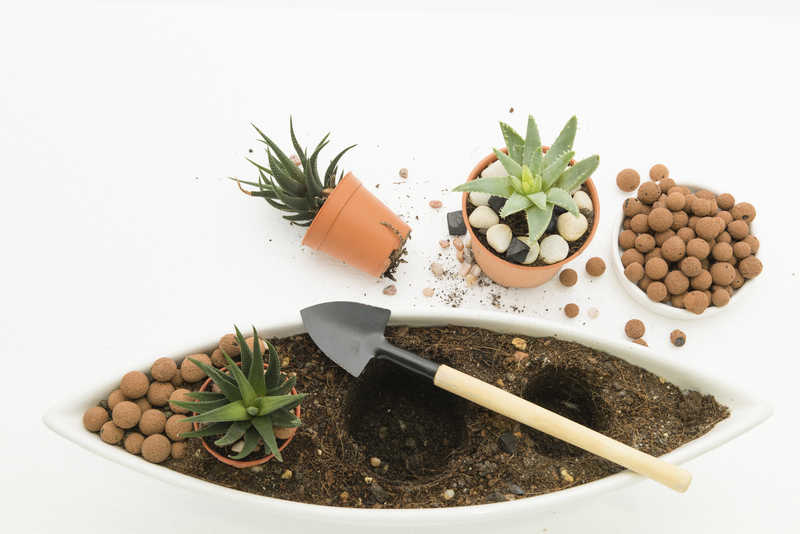Stress-Free Steps to Designing Ideal Garden Seating Areas
Posted on 14/08/2025
Stress-Free Steps to Designing Ideal Garden Seating Areas
Spending time outdoors is one of life's simple pleasures. An inviting garden seating area not only elevates the aesthetics of your yard but also creates a natural retreat for relaxation, social gatherings, and peaceful moments alone. But tackling the creation of an ideal garden seating area can feel intimidating, especially if you aren't sure where to begin. This comprehensive, stress-free step-by-step guide will empower you to design a tranquil, beautiful, and functional outdoor haven tailored to your needs.
- Why Create a Garden Seating Area?
- Step 1: Define Your Purpose and Preferences
- Step 2: Assess & Map Out Your Space
- Step 3: Choose the Ideal Location
- Step 4: Select the Right Garden Seating Style
- Step 5: Create Comfort with Practical Features
- Step 6: Personalize with Style and Accessories
- Step 7: Incorporate Nature into Your Design
- Step 8: Easy Maintenance for Lasting Enjoyment
- Conclusion: Relax and Savor Your Garden Escape
Why Create a Garden Seating Area?
Before we dive into the steps, let’s discuss why investing time and effort into designing your perfect garden seating area is worthwhile. Modern lifestyles benefit immensely from spaces that promote relaxation, mindfulness, and outdoor enjoyment. Well-designed garden seating zones can:
- Reduce stress and boost mental well-being: Regular exposure to green spaces is widely proven to calm the mind and decrease anxiety.
- Extend your living space: Outdoor seating areas give your home extra room for entertaining, dining, or simply unwinding.
- Enhance property value: Thoughtful garden design, including optimal seating spots, increases your property’s curb appeal and value.
- Connect you with nature: Enjoy sunrises, bird songs, or peaceful afternoons outdoors with family and friends.
Step 1: Define Your Purpose and Preferences
Begin with intention. Take time to clearly envision how you want to use your new garden seating area. Ask yourself:
- Will this be a private retreat for reading and relaxation, or a space for entertaining guests?
- Do you envision casual dining alfresco, intimate coffee mornings, or family gatherings?
- Do you prefer sun, shade, or a mix of both?
- What seating capacity will you need?
Jot down your answers and keep them as a reference throughout the design process. Clarifying your goals makes all the following steps much easier, ensuring the final result aligns perfectly with your lifestyle needs.
Step 2: Assess & Map Out Your Space
Survey your yard or garden to determine the best potential spots for your new garden sitting area. Grab a notebook and sketch your outdoor space (it doesn’t need to be perfect!). Mark trees, slopes, existing paths, and sunny or shaded areas.
Key Factors to Consider:
- Size of available space: Measure the area dedicated to your seating and leave enough room for comfortable movement around it.
- Accessibility: Is it easy to reach from the house, and does it connect naturally with other garden features?
- Sunlight and shade throughout the day: Note where the light falls--this affects comfort and the types of plants you'll use.
- Wind direction and privacy: Consider how exposed the spot is and whether you need screens, fences, or hedges for privacy and shelter.
Understanding your garden’s unique layout and microclimate ensures you build a seating oasis that truly suits your site.
Step 3: Choose the Ideal Location
Not all areas in your garden are equally suited for an inviting garden sitting area. Use your notes to review possible locations and test them at different times of the day. Take a chair and sit in each spot for a few minutes to experience the views, sounds, and sun exposure first-hand.
- South-facing sites: Offer plenty of sun--great for warming up during brisk spring mornings.
- Shaded nooks: Ideal for cooling off during summer.
- Near water features, flower beds, or mature trees: Enhance ambiance with natural sights and soothing sounds.
- Hidden corners: Create a peaceful escape from busy or noisy areas (perfect for meditation).
Remember, your outdoor seating area should beckon you outside--it should feel just right every time you settle in.
Step 4: Select the Right Garden Seating Style
This is where your vision and creativity shine. Explore various garden seating ideas to match both your space and sense of style.
Popular Garden Seating Area Options:
- Benches: Timeless and space-efficient, perfect alone or as part of a larger seating ensemble. Consider wood, metal, or stone styles for different aesthetics.
- Outdoor sofas and lounge sets: Offer maximum comfort and seating capacity, ideal for sociable gardens.
- Bistro tables and chairs: Compact, French-inspired charm for morning coffee or afternoon tea.
- Adirondack chairs: Iconic for laid-back relaxation and lakeside vibes.
- Built-in seating: Integrate brick, stone, or timber seats within low walls or planter beds for a seamless, custom look.
- Swings or hammocks: Instantly create a whimsical, relaxing mood for reading or napping under the shade.
When choosing your garden seating options, balance aesthetics, comfort, and maintenance. Mixing and matching seating types--like combining a bench with a loveseat--adds charm and flexibility to your space.
Step 5: Create Comfort with Practical Features
To make your seating area irresistibly inviting, prioritize comfort and practicality from the ground up:
- Quality cushions and outdoor fabrics: Weatherproof cushions instantly boost coziness. Pick fade-resistant and easy-to-clean materials.
- Shade solutions: Use pergolas, umbrellas, arbours, or leafy trees to shelter from harsh sun.
- All-weather furniture: Choose durable materials like teak, powder-coated aluminum, or resin wicker to withstand outdoors year after year.
- Level and sturdy surfaces: Level paving stones, gravel pads, or wooden decking provide secure, stable footing for seats and tables.
- Side tables and storage: Keep drinks, books, or snacks handy.
Pro Tip: Test your layout before you commit. Arrange your chosen furniture in various configurations to discover which feels most natural and inviting.
Step 6: Personalize with Style and Accessories
Make your outdoor seating area a seamless extension of your personality and home. Add finishing touches that delight the senses:
- Textiles: Layer outdoor rugs, pillows, and throws in pleasing colors and patterns.
- Lighting: String lights, lanterns, or solar path lights extend enjoyment into the evening, creating a magical mood.
- Art and decor: Hang weatherproof art, mirrors, wind chimes, or garden statues for added interest.
- Planters and pots: Surround your seating with lush greenery, vibrant flowers, or aromatic herbs.
- Screening and trellises: Add privacy, and support climbing plants or vines for a living wall effect.
Personalized garden sitting areas quickly become beloved retreats you’ll cherish year-round.
Step 7: Incorporate Nature into Your Design
Enhance the harmony between your seating area and the surrounding garden for a truly immersive experience:
- Frame views: Position seats to overlook interesting plants, landscapes, or water features.
- Use fragrant plants: Surround your seating with lavender, roses, jasmine, or herbs to awaken the senses.
- Attract wildlife: Install bird feeders or plant pollinator-friendly flowers to invite butterflies and birds.
- Blend with garden beds: Soften boundaries between hard surfaces and nature by integrating seats with adjacent borders or gravel gardens.
By weaving natural elements into your outdoor seating area design, you boost its beauty and create a restorative sanctuary just steps from your door.
Step 8: Easy Maintenance for Lasting Enjoyment
For a truly stress-free garden seating area, consider low-maintenance features so you spend more time relaxing and less time on upkeep:
- Choose weather-resistant materials: Select furniture, cushions, and rugs built to withstand rain and sun.
- Opt for easy-care plants: Native and drought-tolerant species require minimal watering and pruning.
- Mulch and weed barriers: Keep planting beds tidy with bark mulch or gravel to suppress weeds naturally.
- Storage solutions: Invest in a waterproof deck box or storage bench for cushions and supplies during poor weather.
- Routine cleaning: Periodically clean furniture, wash cushion covers, and sweep pathways to keep your seating area fresh and inviting.
Maintenance shouldn’t feel like a chore--with the right planning, you’ll have more energy to sit back and savor your garden haven.
Conclusion: Relax and Savor Your Garden Escape
Designing the ideal garden seating area is a highly rewarding project that doesn’t have to be stressful or overwhelming. By following these step-by-step principles--defining your vision, planning your space, blending comfort with style, and weaving in the beauty of nature--you’ll create a personal outdoor retreat that enhances your well-being and daily joy.
Whether your taste is modern, rustic, minimalist, or whimsical, a thoughtfully designed garden sitting area becomes the heart of your home’s connection to the outdoors. Invite friends for laughter, entertain with sunset cocktails, or simply carve out time for a peaceful cup of tea surrounded by nature’s sights and sounds--your garden seating space opens up a world of relaxation just for you.
Start your stress-free journey to a stunning, comfortable, and enduring garden retreat today--and reclaim the sanctuary in your own backyard!
Related Resources
- Top 10 Outdoor Furniture Trends for 2024
- How to Choose the Best Plants for Garden Privacy
- DIY Shade Structures for Instant Comfort



